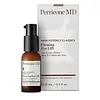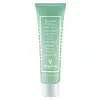What's inside
What's inside
 Key Ingredients
Key Ingredients

 Benefits
Benefits

 Concerns
Concerns

 Ingredients Side-by-side
Ingredients Side-by-side

Water
Skin ConditioningCetearyl Alcohol
EmollientPolysorbate 60
EmulsifyingSqualane
EmollientIsopropyl Palmitate
EmollientTetrahexyldecyl Ascorbate
AntioxidantBenzyl Alcohol
PerfumingPhosphatidylcholine
EmulsifyingDimethyl Mea
BufferingAcetyl Tetrapeptide-5
HumectantPalmitoyl Tetrapeptide-7
Skin ConditioningDipeptide-2
Skin ConditioningHesperidin Methyl Chalcone
AntioxidantUndecylenoyl Phenylalanine
Skin ConditioningCalophyllum Tacamahaca Seed Oil
EmollientSodium Hyaluronate
HumectantCopper Gluconate
Skin ConditioningMagnesium Aspartate
Skin ConditioningZinc Gluconate
Skin ConditioningEmblica Officinalis Fruit Extract
Skin ConditioningEthylhexylglycerin
Skin ConditioningDisodium EDTA
Polyacrylate Crosspolymer-6
Emulsion StabilisingButylene Glycol
HumectantGlycerin
HumectantSteareth-20
CleansingCaprylyl Glycol
EmollientChlorhexidine Digluconate
AntimicrobialPhenoxyethanol
PreservativePotassium Sorbate
PreservativeSorbic Acid
PreservativeWater, Cetearyl Alcohol, Polysorbate 60, Squalane, Isopropyl Palmitate, Tetrahexyldecyl Ascorbate, Benzyl Alcohol, Phosphatidylcholine, Dimethyl Mea, Acetyl Tetrapeptide-5, Palmitoyl Tetrapeptide-7, Dipeptide-2, Hesperidin Methyl Chalcone, Undecylenoyl Phenylalanine, Calophyllum Tacamahaca Seed Oil, Sodium Hyaluronate, Copper Gluconate, Magnesium Aspartate, Zinc Gluconate, Emblica Officinalis Fruit Extract, Ethylhexylglycerin, Disodium EDTA, Polyacrylate Crosspolymer-6, Butylene Glycol, Glycerin, Steareth-20, Caprylyl Glycol, Chlorhexidine Digluconate, Phenoxyethanol, Potassium Sorbate, Sorbic Acid
Glycerin
HumectantWater
Skin ConditioningHelianthus Annuus Seed Oil
EmollientButylene Glycol
HumectantIsodecyl Neopentanoate
EmollientSodium Acrylates Copolymer
Tocopheryl Acetate
AntioxidantRosa Centifolia Flower Water
Skin ConditioningPanthenol
Skin ConditioningAllantoin
Skin ConditioningBisabolol
MaskingTilia Cordata Extract
RefreshingMalachite Extract
AntioxidantArnica Montana Flower Extract
MaskingGinkgo Biloba Leaf Extract
Skin ConditioningAesculus Hippocastanum Seed Extract
Skin ConditioningAlgae Extract
EmollientRosa Damascena Flower Oil
MaskingHydrogenated Polyisobutene
EmollientPEG-40 Hydrogenated Castor Oil
EmulsifyingAcrylates/C10-30 Alkyl Acrylate Crosspolymer
Emulsion StabilisingPhospholipids
Skin ConditioningPolyglyceryl-10 Stearate
Skin ConditioningEthylhexylglycerin
Skin ConditioningDisodium EDTA
Citric Acid
BufferingSodium Hydroxide
BufferingDehydroacetic Acid
PreservativeTocopherol
AntioxidantPhenoxyethanol
PreservativePotassium Sorbate
PreservativeSodium Benzoate
MaskingCitronellol
PerfumingGeraniol
PerfumingGlycerin, Water, Helianthus Annuus Seed Oil, Butylene Glycol, Isodecyl Neopentanoate, Sodium Acrylates Copolymer, Tocopheryl Acetate, Rosa Centifolia Flower Water, Panthenol, Allantoin, Bisabolol, Tilia Cordata Extract, Malachite Extract, Arnica Montana Flower Extract, Ginkgo Biloba Leaf Extract, Aesculus Hippocastanum Seed Extract, Algae Extract, Rosa Damascena Flower Oil, Hydrogenated Polyisobutene, PEG-40 Hydrogenated Castor Oil, Acrylates/C10-30 Alkyl Acrylate Crosspolymer, Phospholipids, Polyglyceryl-10 Stearate, Ethylhexylglycerin, Disodium EDTA, Citric Acid, Sodium Hydroxide, Dehydroacetic Acid, Tocopherol, Phenoxyethanol, Potassium Sorbate, Sodium Benzoate, Citronellol, Geraniol
Ingredients Explained
These ingredients are found in both products.
Ingredients higher up in an ingredient list are typically present in a larger amount.
Butylene Glycol (or BG) is used within cosmetic products for a few different reasons:
Overall, Butylene Glycol is a safe and well-rounded ingredient that works well with other ingredients.
Though this ingredient works well with most skin types, some people with sensitive skin may experience a reaction such as allergic rashes, closed comedones, or itchiness.
Learn more about Butylene GlycolDisodium EDTA plays a role in making products more stable by aiding other preservatives.
It is a chelating agent, meaning it neutralizes metal ions that may be found in a product.
Disodium EDTA is a salt of edetic acid and is found to be safe in cosmetic ingredients.
Learn more about Disodium EDTAEthylhexylglycerin (we can't pronounce this either) is commonly used as a preservative and skin softener. It is derived from glyceryl.
You might see Ethylhexylglycerin often paired with other preservatives such as phenoxyethanol. Ethylhexylglycerin has been found to increase the effectiveness of these other preservatives.
Glycerin is already naturally found in your skin. It helps moisturize and protect your skin.
A study from 2016 found glycerin to be more effective as a humectant than AHAs and hyaluronic acid.
As a humectant, it helps the skin stay hydrated by pulling moisture to your skin. The low molecular weight of glycerin allows it to pull moisture into the deeper layers of your skin.
Hydrated skin improves your skin barrier; Your skin barrier helps protect against irritants and bacteria.
Glycerin has also been found to have antimicrobial and antiviral properties. Due to these properties, glycerin is often used in wound and burn treatments.
In cosmetics, glycerin is usually derived from plants such as soybean or palm. However, it can also be sourced from animals, such as tallow or animal fat.
This ingredient is organic, colorless, odorless, and non-toxic.
Glycerin is the name for this ingredient in American English. British English uses Glycerol/Glycerine.
Learn more about GlycerinPhenoxyethanol is a preservative that has germicide, antimicrobial, and aromatic properties. Studies show that phenoxyethanol can prevent microbial growth. By itself, it has a scent that is similar to that of a rose.
It's often used in formulations along with Caprylyl Glycol to preserve the shelf life of products.
Potassium Sorbate is a preservative used to prevent yeast and mold in products. It is commonly found in both cosmetic and food products.
This ingredient comes from potassium salt derived from sorbic acid. Sorbic acid is a natural antibiotic and effective against fungus.
Both potassium sorbate and sorbic acid can be found in baked goods, cheeses, dried meats, dried fruit, ice cream, pickles, wine, yogurt, and more.
You'll often find this ingredient used with other preservatives.
Learn more about Potassium SorbateWater. It's the most common cosmetic ingredient of all. You'll usually see it at the top of ingredient lists, meaning that it makes up the largest part of the product.
So why is it so popular? Water most often acts as a solvent - this means that it helps dissolve other ingredients into the formulation.
You'll also recognize water as that liquid we all need to stay alive. If you see this, drink a glass of water. Stay hydrated!
Learn more about Water